
The Art of Participation: How Creative Arts Enhance Engagement
Written by Nichola Combe, Project Lead, Capacity Building at Children’s Parliament.
Children’s Parliament adopts a children’s human rights approach, as set out in the UNCRC (United Nations Convention on the Rights of the Child) to develop open and honest relationships with children and young people, and to create opportunities for them to feel safe, challenged, and trusted. The aim of our work is to encourage children and young people to explore all issues in their lives and to consider what they can do to influence their own situation and that of others in relation to these issues. This is done by respecting their human dignity and valuing their opinions and ideas, but these opinions and ideas are not always expressed in spoken words or writing.
All our participation is, therefore, rooted in creative arts practice which helps elicit “voice” by providing children and young people with multiple ways of expressing themselves and engaging them in dialogue with adults who make art alongside and with the children and young people, putting everyone on an equal footing. Methods such as drawing, painting, and sculpting and activities such as puppetry, videography, poetry, drama, and collage can all be used to amplify children and young people’s voices. There are a vast variety of arts-based methods that can be used to meet individual expressive needs, and group art activities help foster discussion and co-operation and provide a space for innovative problem solving. At Children’s Parliament we treat children and young people as equals and that includes putting their artistic endeavours on a par with adults, just as we do their views and opinions.
Our minds can wander freely when we are engaged in fun creative activities. Creative processes include divergent thinking, broad associations, cognitive flexibility, problem solving, imagination, improvisation, pleasure, and absorption. Art encourages us to explore the world around us and to reflect on our lives and learn new things about ourselves in fun ways that involve sensory perceptions and emotion as well as intellectual responses. Creative art activities also promote equality and are empowering. Educationally marginalised children and those with challenges in their personal and home lives find sanctuary, nurture and self-esteem through creative arts and therefore find their voice. When children and young people express themselves through creative arts activities, we can capture ambiguities, liminalities and complexities that may not be easily communicated through words. They empower children and young people to share their stories and perspectives in ways that feel comfortable and safe. Participating in creative arts also plays an important role in supporting children and young people to recognise and value the variety and vitality of local, national, and global culture. Children and young people who take part in regular arts activities show significant improvement in social cohesion, cooperation, and pro-social attitudes, and are more likely to volunteer and to vote as adults.
Doves of Peace
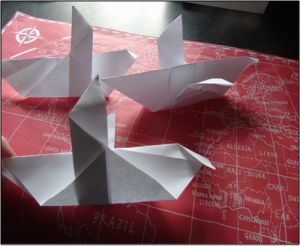
Simple origami doves, decorated inside with our Members of Children’s Parliament calls to action, were made during a participation session linked to one of our projects. The doves were then “flown” as part of internationally renowned artist Michael Pendry’s Les Colombes installation at St Giles Cathedral in Edinburgh to raise hopes for the future and show the power of community following the Covid pandemic. This was part of a citizen art project advertised in the national press that we were able to link to our participation themes. The children and young people were thrilled to be part of a professional installation seen by thousands of adults and felt that their views, and art, were given due consideration and weight.
This could really make adults think about what we are saying.
Children and Families Panel Members
We are actual artists; this is so awesome!
Children and Families Panel Members
Thousands of people have viewed our art. It feels like everyone in the country is listening to us!
Children and Families Panel Members
Finding a permanent home for children and young people’s artwork and Calls to Action.
At the end of our Children’s Parliament Investigates How Professional’s Make Rights Real project we organised a public art exhibition of the children and young people’s framed artwork as part of the launch of our resources and the children’s calls to action. We invited along public authority professionals and families to separate viewings. The children and young people were thrilled to organise the exhibition, choose which pieces would be framed and choose how to display their artwork. They were immensely proud to have their views and opinions given such importance and exhibited in their local community. The children and young people then got to choose their favourite framed artwork to take home, and the rest of their art has now been hung on permanent display at East Lothian Council’s head office highlighting the children and young people’s calls to action on how professionals can make rights real for children and young people. This allowed the participation conversations and the children and young people’s calls to action to be carried on at home, in school and in their wider communities. It gave the work reach, which was meaningful to the children and young people in their own communities, beyond the scope of the project – which was to provide a website with resources to help professionals improve their children’s human rights practice. All the children involved in this project asked if they could take part in wider participation work in the future, with several whole families becoming involved in future projects and one child now aspires to be an MP, demonstrating how creative arts-based practice fosters deeper engagement and enhances participation.
Falkland Honeycomb Mural
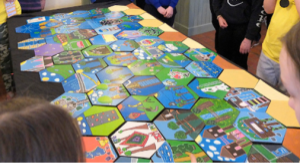
When Falkland’s Centre of Stewardship were working on the development of the Falkland Estate to ensure its sustainability and enhance community involvement, Children’s Parliament were asked to support children and young people’s participation in the development process. We worked with children and young people from local nurseries and schools on the Falkland Imagineers project to capture children and young people’s views and ideas on what they and their families value about Falkland Estate and how people of all ages could best enjoy playing and learning on the Estate now and in the future. The children and young people’s drawings of their ideas were integrated into a Honeycomb mural which has now become part of the landscape at Falkland.
The Weaving of Stories
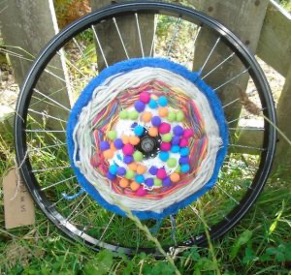
Families from across Scotland came together as the Children and Families Panel of our Children’s Rights Skills and Knowledge Framework project team. They were tasked with sharing their experiences of family life in contemporary Scotland and giving their views on what adults need to know to ensure that children’s rights are fully implemented in Scotland. Their views ensured that children’s voices were at the heart of the Framework. The Children and Families Panel participated in a group art project to consolidate family thinking on the skills and knowledge needed for the Framework. Recycled children’s bicycle wheels, representing childhood, were used as mini frameworks to produce abstract weavings of the core values of children’s rights, pulling together the threads of individual families’ stories and lived experiences. The wheels were then brought together to make a kinetic sculpture consolidating the whole panel’s views. The different colours and textures of yarns represent the rich diversity of families in Scotland. The kinetic element represents the children’s rights movement and reminds us that learning is an ongoing process, and that we all need to slow down and reflect on children’s rights. The wheel weavings were exhibited in Stirling where adults were invited to join the movement by walking amongst the sculptures while reflecting on your own childhoods, and on what they personally could do to ensure that every child in Scotland grows up happy, healthy and safe.
Everyone is an Artist
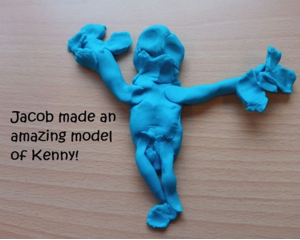
On one of our Children’s Parliament projects I worked with a nine-year-old Member of Children s Parliament who was profoundly dyslexic and whose difficulty with pencil control made it almost impossible for them to draw or paint. After a bit of experimenting with various materials we found that playdough was an effective way to get their thoughts down and through that medium the Member of Children’s Parliament was able to share with us their traumatic experience of being in foster care. They then provided amazing insight and innovative ideas about how social workers could improve their children’s human rights approach when they were meeting a foster family for the first time which we were able to use in an online learning resource for professionals. The children and young people interviewed their Westminster MP as part of their research for this project. Our dyslexic Member of Children’s Parliament made a playdough model of his MP and gave them a photograph of it to keep. The MP later wrote a special letter from The Houses of Parliament, thanking them for the “amazing likeness in your fantastic artwork” and explaining that the photograph of the model had been framed and given pride of place on the wall in his Parliamentary office. Our Member of Children’s Parliament, who was experiencing many challenges in school and home life, was beyond thrilled and filled with pride and a sense of achievement. A year later when I met up with that Member of Children’s Parliament for a feedback session the first thing he said to me was “I’ve still got my Houses of Parliament letter, I’m keeping that safe to show my grandchildren.”
Eloquent Expression
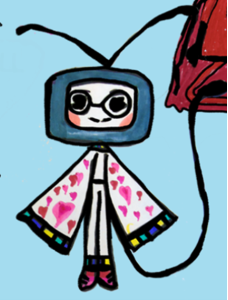
One of our ten-year-old autistic Members of Children’s Parliament felt unable to talk about their feelings openly in front of everyone but was desperate to share their views. Sometimes any conversation at all was difficult so we simply asked them what would work for them. They chose to draw pictures, sometimes removing themself from the group altogether to do so. We had a relaxed attitude to this and allowed them to come and go as they pleased. One day we were talking about love being a core value of children’s rights and this Member of Children’s Parliament asked to draw a superhero of love. At the time everyone in the group complimented them on their unique drawing and they smiled and said, “It’s probably not what you think, but I don’t want to elaborate at the minute.”
We used the drawing in our Feelings Inspectors programme as one of a group of Superheroes of Mental Health and Wellbeing and the child was thrilled to see their character as part of a professional learning resource. A few months later, once they felt more comfortable with the group, and while I was asking the children for feedback, our wonderfully artistic and eloquent Member of Children’s Parliament produced a new picture and accompanying text on what being a Member of Children’s Parliament, and participation had meant to them.
Before I felt silly and drew myself small and trapped in a box, but now I have drawn myself as a huge fierce Japanese dragon who is calm and nice, and the queen of love who knows she is perfect just the way she is. She is called Kikisumi and is powerful. She will call you perfect the way you are too. Kikisumi is me! I know I am fierce now.
Children and Families Panel Member
Wild Ideas
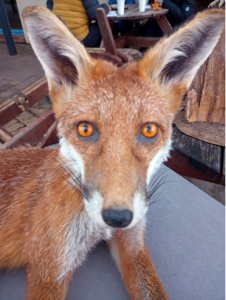
Sometimes you just cannot link what you are doing to a relevant creative art activity because of the subject matter. In those situations, you need to think creatively. As part of a series of interviews with professionals one of our Members of Children’s Parliament was keen to interview the local countryside ranger. Due to Covid we had to carry out these interviews outdoors in the school playground in very windy conditions. We decided to have a taxidermy safari where the ranger brought along stuffed animals, and we centred our interview questions around what wild ideas professionals might employ to ensure that children’s rights are respected. There followed great discussions about how children and young people could be free, like wild animals, and comparisons on the things that animals versus children needed to be happy, healthy, and safe. The children and young people then took their own photographs of the animals, learning photography skills in the process, and feedback showed that this was one of the most fun and favourite engagement sessions of the whole project.
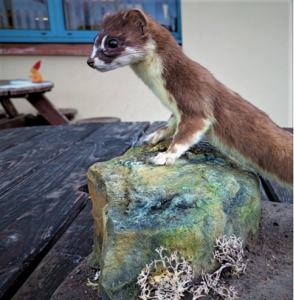
By giving agency to children and young people to express themselves through creative arts we empower them to explore their own stories and lived experiences in a way that they choose and allow children and young people the headspace and time to formulate considered and meaningful answers when seeking their views and opinions. The process enables children and adults to collaborate in a mutual space while sharing ideas which may be difficult to put in writing. Creative activities also provide diverse ways for children and young people to express feelings and emotions all of which ensures that we are effectively meeting their right to be heard.
Blog series from the UNCRC Skills and Knowledge Framework programme, more information here: Children’s Rights Skills and Knowledge Framework